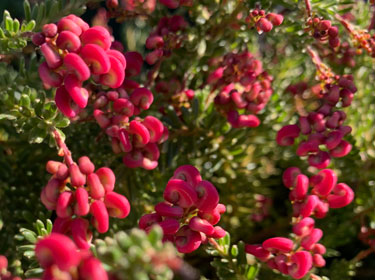Jewels of the garden
Australia is home to over 350 species of Grevilleas, with just a handful native to Asian and Pacific islands. There are many hundreds more varieties so there is a Grevillea to suit almost any garden.
With so many varieties it is not surprising that they are very diverse in their growth habits, flower styles, colour, and foliage. They can be used as as hedge plants, feature shrubs or trees, as ground cover and even weeping standards.
Depending on the variety, the flowers have been described as “spiders” and “toothbrushes” but a close look reveals they are neither. The intricate and complex structure that is called the flower, is a work of art and not something that mankind can emulate; and they are certainly far more beautiful than any spider.
The colour range and combinations is quite enormous, from bright reds, oranges, and yellows to hues of pink, mauve and cream. Grevillea “Bonnie Prince Charlie” is bejeweled with ‘spiders’ of bright red and yellow, while Grevillea “Peaches and Cream”, combines salmon and soft yellow in a whispery floral ‘toothbrush’. Some varieties will flower throughout the year, but they are mainly enjoyed through winter when their bright flowers are conspicuous in the absence of others.
Grevillea flowers all contain nectar so are perfect to grow in a wildlife garden, attracting both bees and birds. Tui, bellbirds and wax eyes love the larger ‘toothbrush’ flowers, and honeybees will happily attend to the smaller ‘spider’ flowers.
Grevilleas are very easy to grow and are ideal in a dry "water wise" garden. All Grevilleas love full sun and because they don't like wet feet they will adore a sloping or raised garden bed. Dry conditions and long periods without rain will not trouble them.
To plant, choose a place in the garden that gets full to partial sun, and where the soil is free draining. Dig a planting hole twice as wide and to the same depth as the root-ball, and only mix in compost if the soil is poor quality or sandy. Like their Proteaceae cousins, Grevilleas do not require much in the way of fertiliser and dislike phosphates. Feed only annually with a controlled release fertiliser low in Phosphorous. Water in well at the time of planting but once established, additional water will only be required in very dry periods.
Regular pruning of Grevilleas is recommended to maintain bushiness and encourage additional flowering. Prune after the main flowering period, which can be tricky with the varieties that have a long flowering time. It is worth the sacrifice of a few flowers for another main flowering display. Remove any dead or non-productive wood back to a main branch or the trunk as required.
Grevilleas for ground covering
- Grevillea “Bronze Rambler” has beautiful bronze-coloured new foliage and wine red ‘toothbrush’ flowers. It is perfect for densely covering ground and trailing over banks and walls. Grows to about 20cm high and spreads to 1.2m.
- Grevillea “Drummer Boy” has fine soft grey-green foliage. The red buds open to a showy display of pink and cream ‘spider’ flowers. Grow to 15cm high and a spread of 40cm. Ideal ground cover on banks and blended around rocks.
- Grevillea “Sea Spray” has beautiful soft silver foliage that cascades over the ground, providing a backdrop to the startling bright red ‘toothbrush’ flowers. Grows approx. 75 x 75cm.
Grevilleas for shrubberies and hedging
- Grevillea “Bonnie Prince Charlie” is a cute shrub with bright green fine leaves and vibrant clusters of red and yellow ‘spider’ flowers. Provides a splash of colour in the winter garden. Grows approx. 60cm tall x 100cm wide.
- Grevillea "Eureka" is a small shrub gorwing 75cm x 1m wide with striking golden yellow 'spider' flowers.
- Grevillea "Knockout" is a small tough plant with an amazing display of orange/yellow 'spider' flowers in spring and summer. Grows to 1m x 1m.
- Grevillea “Poorinda Peter” has stunning dark green foliage, bronze when new, and burgundy -purple 'toothbrush' flowers year-round, peaking in Summer - great for attracting native birds. Can be grown as a dense spreading hedge. 2-3m high and 2-4m wide.
- Grevillea “Scarlet Sprite” is a super hardy, low maintenance shrub that can be trimmed to form a low border hedge. The fine needle-like leaves are a bit prickly but make a good deterrent where feet aren’t wanted. The bright red ‘spidey’ flowers are prolific during winter and spring. Grows up to 1m tall and wide.
- Grevillea "Superb" is a large colourful shrub that can be used as a hedge or specimen plant. Attracts nectar feeding birds with the beautiful large orange-reddish 'toothbrush' flowers. Grow to 2m x 2m.
Grevilleas as trees
- Grevillea “Robin Hood” is often regarded as the best Grevillea. Described as a small tree, it grows to 3m tall by 2m wide, and flaunts 10cm scarlet ‘toothbrush’ flowers from spring through summer. The nectar rich flowers attract tui, bellbirds and wax eyes.
- Grevillea robusta or Silky Oak, grows up to 8m high and 6m wide in 10 years. This tree makes an impressive specimen as in spring, the tree is garlanded with large golden clusters of flowers that are a magnet to nectar seeking birds.

30-May-2021

Grevillea Bronze Rambler

Grevillea Drummer Boy

Grevillea Seaspray

Grevillea Bonnie Prince Charlie

Grevillea Eureka

Grevillea Knockout

Grevillea Poorinda Peter
![]()
Grevillea Scarlet Sprite

Grevillea Superb

Grevillea Robin Hood

Grevillea robusta 'Silky Oak'

